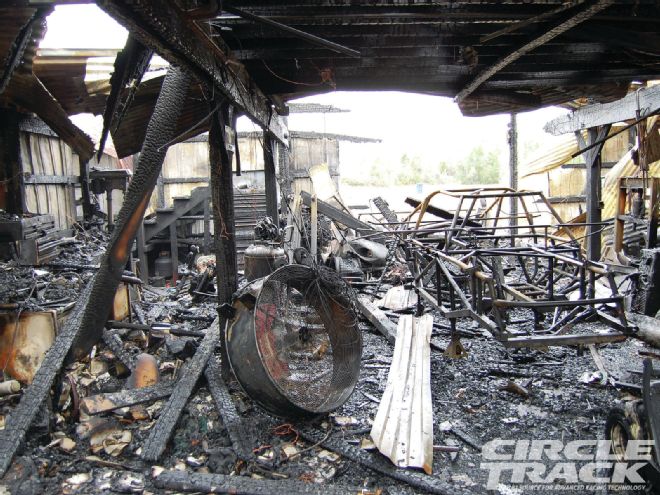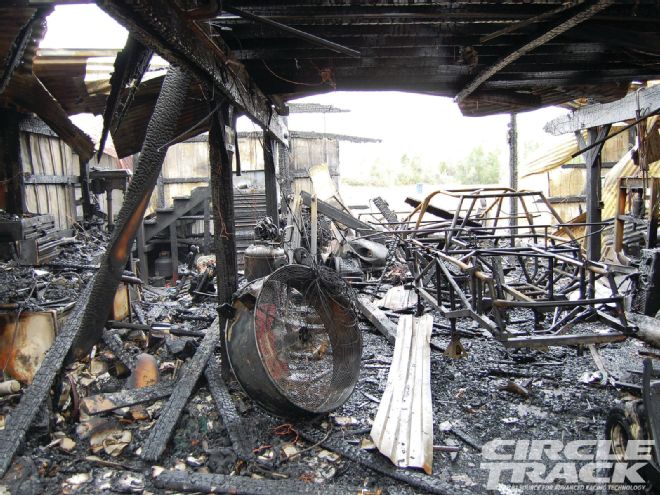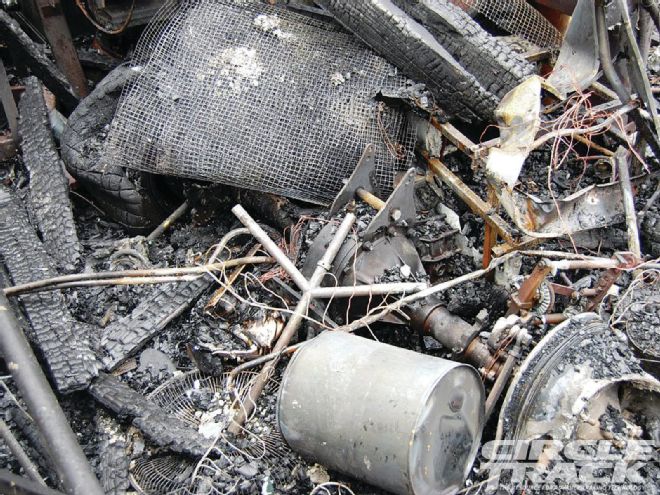
As racers, there are certain things we prepare for. Every time the car gets unloaded at the track, the odds of a wreck or broken parts are pretty good. Racers and crews all over the country spend countless hours leading up to each race preparing race cars to avoid part failures, and are ready to spring into action in the event of a crash. But are you prepared for those unexpected incidences and circumstances that can be more devastating that most on-track accidents?
Kyle Johnson races a Limited Sportsman (Dirt Late Model) in Louisiana and Alabama, but a fire destroyed nearly his entire racing operation. The building was a barn on a 30x40-foot concrete slab, and all that's left now is the slab. "My shop is the common Saturday night racer's setup," explains Johnson. "It was made out of my family's 30x40-foot shed that had a loft upstairs that we used for doing woodwork and for storage. I bought and built items and equipment that a racer needed to maintain a race program. I had TIG and MIG welders, a drill press, a shop press, a parts washer, all sizes of tubing and metals, and any tool I needed to work on cars. When it came to tools and such, I deemed it as an investment and did not skimp on items of importance. I had a plan to equip my shop with everything to build and maintain a car 'in-house,' so I didn't have to drag the car to other shops to get work done, especially since my daughter wants to race, and soon I'll probably be buying her a car.
 Kyle Johnson’s race shop was not unlike most backyard racers. Unfortunately, an arcing wire left him with what you see here.
Kyle Johnson’s race shop was not unlike most backyard racers. Unfortunately, an arcing wire left him with what you see here.
"After the Christmas holidays, I started to get the car ready for the 2012 race season. I had intentions to try to acquire sponsorship and race for points, due to our track getting NeSmith sanctioned for this year.
"I attended a racers auction in Birmingham, Alabama, and acquired body parts and other items to upgrade the car and put a new body on it. I stripped every component off and had a bare frame. I replaced the driver-side framerail from crossmember to four-bar mount and replaced the J-bar mount. This was done the first week of February. All the welding was complete and the primer coat applied after the completion of the framerail work.
"On the evening of February 15, 2012, I got assistance from my dad and son to help me flip the chassis back right side up and put it on jackstands. All that was left was to weld a piece of 3/4-inch square tubing to the rear of the chassis for a spoiler/deck support, which required four small welds.
"After the welds cooled, I put a primer coat on it and sat down to watch some TV. Then I applied a first coat of paint and sat and watched a little more TV. The total time in the shop after welding was probably about 1 hour and 15 minutes--I remember because I went inside and washed up to watch American Idol. Around 9:15 p.m., my wife and kids arrived home from church. To get to the house, you must drive up about 150 yards of driveway, the whole time facing the shop (part within 90 feet of it), and nothing was out of the ordinary.
"At about 10:30 I remember hearing a faint boom, but figured it was someone in the woods head lighting deer. Moments later, I heard several more explosions and stepped outside to investigate. That's when I looked out and saw all my hard work and investments up in flames. The shop was completely engulfed in flames, and I call[ed] 911 to get help. One key thing I said in the call was the presence of Oxy/Acetylene bottles and the amount of tires inside, as well as the other chemicals. This helped the East Central Volunteer Fire Department to be prepared for what to expect and the manpower needed.
"My dad, neighbors, and I went into action moving vehicles, boats, mowers, and whatever else we could get away from the shop safely. When the fire department got there, they were in full force. It took over three hours to extinguish the fire. The hardest part was where I had 20 or so tires stored upstairs, because they couldn't get an angle of attack.
"We all dreaded the next morning. A call was made to the insurance company and it was sending an adjuster that afternoon, so we couldn't touch anything. Also a state investigator was coming that morning. Everything was a total loss at first look. Words cannot describe what it is like to see all your hard work and dreams in a pile of ashes. Not only did I lose my tools and racing stuff, but family items also. My dad's woodshop, three freezers with meats and vegetables from fall harvest, holiday decorations, and all our fishing and camping gear I've collected for 20-something years was gone. It is by the grace of God a north wind wasn't blowing to push the fire toward the house and vehicles.
"After about four hours of investigating, the state investigator determined it was an electrical fire. An arced out piece of Romex was found going to an untripped breaker. The wire was behind a wall where the bathroom was. This area was also where all the paints, parts washer, my tires and wheels that were on the car, as well as the Oxy/Acetylene bottle cart were stored. So, the arced out wire must have caught the wood or something on fire and quickly spread. Inside the bathroom were two boxes of shop rags, catalogs, and four years of Circle Track magazines, so if the wire was near that, then the paper could have been an accelerant. We don't know how it arced, but assume it was either a mouse bit it or a power surge. The only thing plugged up was my welding machine, the freezers, and my battery chargers."
The National Fire Protection Association (NFPA) is responsible for more than 300 fire safety codes and safety standards, which can be accessed at www.nfpa.org. Although most of these codes are designed for commercial or industrial environments, proper storage and handling procedures for fuel, chemicals, and new and used petroleum products are covered, which can be easily applied to any small private or home shop. To get more information on what the NFPA has available, we spoke to Ken Willette, Division Manager for the Public Fire Protection Division.
"The NFPA started in the Boston area in 1897," explains Willette. "It was a consortium of insurance companies that came together and developed standards that would allow them to have improved fire protection systems in buildings. Over the years it has evolved to where areas of fire safety, electrical safety, building safety, storage of chemicals and hazardous material, and responder safety became part of the library of documents the NFPA produces."
We wanted to get some detailed information, so we spoke with Fire Service Specialist, Ryan Depew, who explained more about some of the NFPA's codes and standards that specifically relate to shops and service centers.
"Repair garages (and race shops) will find beneficial [safety] information within the NFPA standards," explains Depew. "For people that are running private shops, whether it be at home or not, the information may be a little outside of the scope, because they aren't running a business, but there is certainly useful information to look at and utilize from a safety standpoint. Just to break it down, we have the National Fire Code--NFPA-1. That's going to cover all of the different occupancies, including garages. We have a lot of information on hazardous materials storage, and proper storage for different types of chemicals."
From the handling and storage of chemicals and hazardous materials commonly found in race shops, to proper disposal of used oil and oily rags, to welding and cutting safety, the NFPA has codes and standards that can help add a higher level of safety to any shop.
(Editor's note: The codes and standards published by the National Fire Prevention Association [NFPA] are designed for commercial, industrial, and manufacturing facilities. Although the information in these codes may not be required in your shop, the information can offer many safety and fire prevention tips that can minimize the risk of fire.)
Kimberly Sheara is a Liability Adjuster for the top commercial insurance company in the U.S., and is a good friend of the magazine. We got in touch with her about best practices when it comes to insuring your shop.
"You need to be very specific to ensure you have the correct amount of coverage," explains Sheara. "You need to take stock of what you have--equipment, tools, materials, essentially everything in the shop, then go see an agent and explain what you have and what you want covered. Don't do it on the Internet or over the phone, as the general policies aren't going to cover high-dollar items like race cars. A reputable and experienced agent who's written policies for shops before will get you the correct policy and all of the correct endorsements."
Sheara also informed us that not everything in your shop can be covered under one policy. "Anything that can have its own policy will not be covered. For example, a boat, a car, or an ATV or golf cart should have its own policy, and in most cases, will not be covered."
NFPA 1--The National Fire code
NFPA 13--Standard for installation of sprinkler systems
NFPA 20--Standard for the installation of stationary pumps for fire protection
NFPA 30--Flammable and Combustible Liquid code
NFPA 30A--Code for motor fuel dispensing facilities
NFPA 30B--Code for manufacturing and storage of aerosol products
NFPA 51B--Standard for fire prevention during welding, cutting, and other hot work
Beyond these, the NFPA has many more codes and standards that would apply to a race shop. Visit www.NFPA.org for more information.
 If you look closely, you can see what’s left of a quick-change rearend buried in the rubble.
If you look closely, you can see what’s left of a quick-change rearend buried in the rubble.